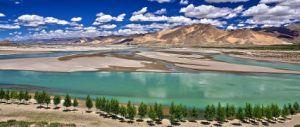The Cambodian prime minister is in China’s good books. In a recent – and friendly – speech, Hun Sen said that this year’s record low water levels on the Mekong River have been caused by irregular rainfall triggered by climate change and that linking it to the construction of Chinese hydropower dams is misguided.
On November 18, when reporters asked China’s Ministry of Foreign Affairs spokesperson Hong Lei what he thought of Hun Sen's remarks, he said: "China and downstream countries are good neighbours and our development in water resources exploitation on the Lancang-Mekong River is fully consistent with the interests of those countries along the Mekong River. As a responsible upstream country, China has always attached great importance to environmental and ecological protection during the development of water resources on Lancang River and fully considered the concerns of downstream countries.”
Two days later, however, the Washington Post published an article saying experts are predicting China's dam construction on the Mekong will devastate the lives of millions of people who rely on eating fish from Cambodia's inland lake, Tonlé Sap – something Cambodia has not criticised Beijing over. The article says: "The perennial question about China's rise is: when will Beijing be able to translate its cash into power. In Cambodia, it already has.”
Whatever the Cambodian president says, international concerns about China’s dam-building activities on transboundary rivers have clearly not gone away. And Chinese scholars continue to debate the issue. Here, in an in-depth, three-part essay, professor Qin Hui of Tsinghua University offers his views.
China’s hydropower development on the Lancang River (known as the Mekong once it leaves China’s borders) has prompted criticism from countries downstream in south-east Asia. In particular, extremely low water levels seen on stretches of the river during this year’s drought in south-west China, triggered intense media scrutiny in countries including Thailand and Laos.
Speaking at a press conference in March, an official from China’s Thai embassy responded to the outcry by repeating the usual refrain that “outflow from China into the Mekong only accounts for 13.5% of the volume at the river mouth”. He pointed out that the surface area of the reservoirs behind China’s three dams on the river – at Manwan, Dachaoshan and Jinghong – is very small and results in negligible evaporation, while hydropower generation does not actually consume any water and therefore has virtually no impact on the river. And so on.
On a recent research trip to south-east Asia, I heard frequent complaints that China’s hydropower development is causing all sorts of environmental problems downstream. There was no – or at least not enough – evidence for many of these claims, a point I constantly put forward. But I still find China’s official response inappropriate, not to mention ineffective at clarifying the true situation. In fact, this stance could easily be used against China, as it gives the impression the country is trying to pull the wool over the eyes of its critics – particularly given that the statement made in Thailand was written not by the embassy, but by China’s hydropower authorities.
First, let’s deal with the claim that outflow from China accounts for only 13.5% (some say 14% or 16%) of the Mekong’s flow when it reaches the sea. This has been a catchphrase for Chinese officials in the past few years and has some validity in relation to problems occurring far downstream, particularly near the river’s mouth. Vietnam’s complaints about seawater intrusion in the Mekong Delta are one example. The bulk of the water in that part of the river does not come from China and so we can legitimately argue there is no reason to point the finger in that direction.
However, for most of the length of the river outside of China’s borders, outflow from China accounts for a much larger proportion of overall volume. For example, at Luang Prabgang in Laos, on average two thirds of the river water has come from China. So we cannot claim that the problems in these places have nothing to do with China. The floods around the Laos capital of Vientiane in 2008 and the historically low water levels seen in certain areas this year all occurred on stretches of the river where most of the water comes from China. In these cases, there is no sense in pointing out that China accounts for only a small proportion of the flow at the river mouth.
Drought was of course a contributing factor to this year’s low water levels, but with so many huge dams on the river China needs to back up its claims that the changes in flow were entirely natural. Talk of small surface areas, low evaporation and hydropower not consuming water are transparent attempts to fob off China’s critics. The impact of a reservoir downstream has nothing to do with “water consumption” or “evaporation”, but the impoundment and release of water. Opening or closing floodgates has a huge impact on downstream flow. Otherwise, how could we talk about reservoirs preventing floods and relieving drought?
Of course, the impact is limited to the capacity of the reservoir. And so we talk of dams being able to regulate downstream flow on a daily, monthly, seasonal, annual or multi–year basis. But China has a huge capacity to do this. Yes, only some 14% of the water at the Mekong’s mouth comes from China. But 70% of reservoir capacity in the Mekong Basin is within China – and this will rise to 90% when the Nuozhadu dam (a nine generator scheme under construction in Yunnan) comes into operation. Moreover, all of China’s Mekong reservoir capacity is on the river proper, while other nations have built dams only on tributaries.
Our officials describe the Manwan, Dachaoshan and Jinghong reservoirs as being “of small surface area”. But a reservoir’s effects depend on its volume. Why talk about the area? These three dams are all over 100 metres high, with reservoir capacities of 920 million, 940 million and 1.4 billion cubic metres respectively: in total, the equivalent of three Dianchi lakes.
The Manwan and Dachaoshan dams are said to be able to regulate river flow on a seasonal basis, while Jinghong can do so on a monthly (some sources say seasonal) basis. So at the very least, they can influence seasonal river flow downstream. We can argue about whether that is a positive or negative influence, but to disregard common sense and claim these reservoirs have no impact – and then to muddy the issue with talk of “evaporation” – simply makes China look bad.
Particularly bizarre is the fact that China’s officials for some reason talk of the “three reservoirs of the Lancang”, when domestic media have reported on a much bigger fourth project: the Xiaowan dam. Electricity generation here started in September 2009 and, at a height of 300 metres, it is the world’s highest arch dam. Its power-generating capacity is claimed to be second only to the Three Gorges dam, while reservoir capacity is variously said to be 15.3 or 14.6 billion cubic metres – almost five times the total capacity of the other three reservoirs.
If all the water flowing into the reservoir was impounded – cutting off the river completely – it would still take four and a half months to fill it from empty. And then if a dry period saw river levels fall to half of normal, the release of water could restore normal flow for a full 10 months. You could call that quite a substantial “impact”.
According to the hydropower industry, Xiaowan has the ability to regulate river flow on a multi-year basis and is a “tap” that can ensure hydropower stations downstream – including at Jinghong near the border – enjoy a steady flow of water through both the wet and dry seasons. And yet China’s officials speak of “virtually no impact”. Nations downstream suspect the Xiaowan reservoir is still being filled, since it is so big and the dam only started working in September, 2009. Even a severe drought like the one this year could be exacerbated by a huge reservoir being filled upstream. To determine whether or not this did happen, we must look at how the reservoir was actually operated. Simply claiming there is no impact at all will fool no one.
Furthermore, we know that work started on an even bigger reservoir – at Nuozhadu – in 2006 and that the river has already been dammed. With a capacity of 23.7 billion cubic metres, this scheme will also be able to regulate river flow over a number of years. Not only is it bigger than Xiaowan, but it is also nearer the border. Once that reservoir starts filling, will China again claim it has a small surface area, doesn’t evaporate much, consumes no water – and has “no impact”?
The inevitable conflict
It is impossible for a large reservoir to have “no impact” downstream. The right question is: what kind of impact? It can be positive or negative, depending on how the reservoir is built and – more importantly – how it is operated. There are myriad ways to run a reservoir but, simply speaking, there are two basic methods:
One is to manage the reservoir with the aim of preventing floods and relieving drought – in other words, positive regulation. Usually this means emptying out the reservoir until flood season and then storing as much water as possible to lower flood peaks downstream, bringing the reservoir to capacity just as the season ends.
During the dry season, natural flow is passed through and supplemented with water from the reservoir to increase downstream flow, bringing water levels behind the dam to their lowest point by the time the next flood season starts. This relieves both floods and dry periods, evening flow out between the two seasons, and is normally welcomed downstream. But it conflicts with the demands of electricity generation and the need to prevent silt accumulation in the reservoir.
The second method of reservoir operation is almost the direct opposite: store clean water and let silt-laden water flow out. Flood waters carry higher levels of silt than regular flow and this settles on the reservoir floor when the water is impounded. To prevent a build up of sediment and maintain reservoir capacity, it makes more sense to allow flood waters to pass through the dam and instead to store water during the dry season, when there is less silt. And as electricity generation depends on the flow and the head – the height of the water in the reservoir relative to the height the water level on the other side of the dam – storing what little water there is during dry season makes sense as it helps keep the reservoir high.
However, this is exactly what downstream neighbours want to avoid and, if carried through fully, exacerbates both flooding and drought. Both the Three Gorges Dam and Samnmenxia dams use this method to varying degrees and have presented it as a great innovation. In reality, it is an obvious way of boosting power generation and maintaining capacity but is completely at odds with the original aim of preventing floods and relieving drought. Severe sedimentation – particularly at Sanmenxia – made it necessary. Although experts did their best to come up with sophisticated ways of regulating flow by way of a compromise, the reservoirs’ ability to function as intended has been greatly reduced and, at Sanmenxia, is as good as abandoned.
So the interests of the dam operators (maintaining capacity and generating power) and those of downstream residents (preventing floods and relieving droughts) often conflict. Given this, it is understandable if those operating the dams on the Lancang and populations downstream express differing needs.
A Thai official was quoted in the Chinese press as saying – in response to criticism of China in his country – that, since Chinese dams do not impound water during the dry season, the unusually low river levels were instead caused by a drought brought about by global warming.
This official presumably had not heard the theory that Chinese dams do exactly this. Whether or not these reservoirs are storing water in the dry season needs to be clarified by China’s own authorities. Some say China has actually been doing the opposite – releasing water to relieve drought. And, equally, if that is the case Beijing should make it known. But instead, the country’s officials talk solely of “no impact” and “evaporation”.
This article was first published in the Economic Observer. It is reproduced here with permission.
Qin Hui is professor of history at Tsinghua University.
NEXT: Attracting unnecessary suspicion
PART THREE: Taking lessons home
Homepage image by immu



